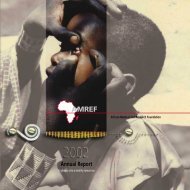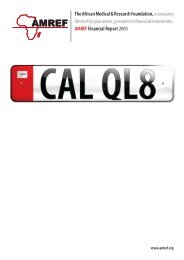Celebrating African Motherhood - Amref
Celebrating African Motherhood - Amref
Celebrating African Motherhood - Amref
Create successful ePaper yourself
Turn your PDF publications into a flip-book with our unique Google optimized e-Paper software.
In the female ward a woman with a deep cut on her head received<br />
oxygen and IV fl uids, and was also connected on a ventilator. Even<br />
though the AMREF team found many more patients who would have<br />
benefi tted from being moved to Nairobi immediately, they had to<br />
make the diffi cult decision to airlift only seven, which was all the<br />
chopper could accommodate.<br />
The Makindu Police transported the medics and patients to the<br />
airstrip, and they were airborne at 6.40pm. On board, the patients<br />
were continuously monitored to ensure that they were as comfortable<br />
as possible. When they landed at the Wilson Airport at 7.30, three<br />
AMREF Flying Doctor Service ambulances and another from the<br />
Kenyatta National Referral Hospital were waiting to take the patients<br />
to the hospital.<br />
And thus, as a result of the hard work of the staff at the Makindu<br />
Hospital, the generous cooperation of the Police Air Wing and Makindu<br />
Police, the speedy response of AMREF’s Flying Doctor Service, and the<br />
professional care of the fl ight staff , seven Kenyans had been set on a<br />
road to recovery that they might never otherwise have taken.<br />
Facts and Figures<br />
• In 2009 AMREF Flying Doctors Emergency Service (FDES) evacuated a<br />
total of 737 patients by Air and/or Ground Ambulance. These included<br />
388 non-members, 256 registered AMREF FDES clients, 48 members<br />
of the Flying Doctor s’ Society of Africa, and 45 free evacuations.<br />
• A total of 748,541 miles were fl own on evacuation fl ights, a decrease of<br />
19 per cent, refl ecting eff ects of the recession on all levels of travel.<br />
AMREF IN ETHIOPIA<br />
AMREF in Ethiopia was established in 2002 and is working in four parts<br />
of the country – Addis Ababa, Afar, Oromia and the Southern Nations,<br />
Nationalities, and People’s Region. In 2009, the country programme was<br />
able to grow despite the challenging environment created by the global<br />
fi nancial crisis. Newly funded projects are bigger than previous ones – they<br />
have larger budgets and longer programme duration.<br />
AMREF in Ethiopia was successfully re-registered as an international Non-<br />
Governmental Organisation in Ethiopia as per the requirements of the new<br />
Civil Society Organisation (CSO) legislation, passed in January 2009. New<br />
grants were received from the European Union and the Department for<br />
International Development (DfID) in partnership with AMREF in UK, and<br />
from AECID through AMREF in Spain to improve the health of pastoralist<br />
communities in Afar and South Omo.<br />
The Programme successfully published a compilation of its annual<br />
performance reports and a booklet comprising 20 abstracts. Two research<br />
fi ndings from Ethiopia were published in AMREF’s case studies series.<br />
Challenges<br />
• Skyrocketing cost of living and infl ation, high cost of construction<br />
materials for building health infrastructure such as health posts, and<br />
weak capacity of the local market to deliver goods and services on time<br />
• Drought and epidemics such as acute watery diarrhoea in our areas of<br />
operation<br />
• Uncertainty over impact of the new CSO Law on the operations of<br />
NGOs in the country<br />
Programme Growth<br />
The Programme’s budget increased from US$5.3 million in 2008 to US$6.3<br />
million in 2009.<br />
Achievements<br />
In the year 2009, AMREF in Ethiopia reached more than 1,550,000<br />
benefi ciaries (500,000 directly and over 1.05 million indirectly). The direct<br />
benefi ciaries included 68,149 mothers, 4,701 children, 76,641 in-and-out of<br />
school youth, 2,530 volunteer mother coordinators, 3,744 volunteer homebased<br />
caregivers, 50,613 community leaders, 107,000 trachoma patients,<br />
and 1,737 health care professionals. AMREF constructed 13 new health<br />
posts and equipped 17 others. These benefi ciaries have received training<br />
or information on HIV, trachoma, polio, malaria and harmful traditional<br />
practices; reproductive health issues, water and sanitation, and skills in<br />
income generation.<br />
15





